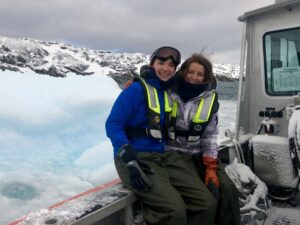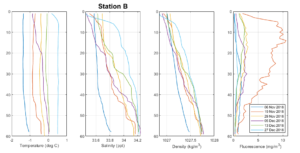-
RUCOOL Updates August-September 2019
Posted on October 18th, 2019 No commentsField Campaign & Science Updates
State
- Joseph Brodie served as a panelist at the third annual Time for Turbines Offshore Wind Conference, hosted by the Business Network for Offshore Wind and Jersey Renews. The panel addressed environmental concerns around offshore wind development, and included NJDEP Deputy Commissioner Debbie Mans as a panelist.
- The RV Rutgers completed 12 cruises supporting 105 passengers. In addition to the cruises supporting DMCS research and glider deployments, these voyages included multiple undergrad classes that received training on plankton tows, water sampling/filtration, oxygen and chlorophyll measurements, and bacteria sampling.
- The first fall semester of the new Master’s program in Integrated Ocean Observing is well underway. Students are engaged in the principles of ocean measurement, building their own sensors from scratch, and are getting hands-on experience with real-world operations with the COOL group including glider deployments, rescue planning, and side scan sonar observations
- Masters students have and will continue to participate in national Marine Technology conferences and career networking events this fall.
National
- The RUCOOL Glider team was involved with five deployments in August and September. These deployments include work supporting NJDEP water quality research along the NJ coast, NASA research off of central California to validate a new sea surface height satellite, and NOAA and privately funded investigations of hurricane interactions with the ocean surface in the Mid-Atlantic Bight and Caribbean.
- RUCOOL deployed two Navy gliders in partnership with the Navy, NOAA OAR, MARACOOS and Monmouth University. Within two weeks, both gliders called into the Navy pilots, indicating that there were leaks. RUCOOL scrambled vessels from NorthStar Marine to recover these gliders at 3am on Sunday, September 22, and at 2am on Sunday, September 29. Both were recovered approximately 100 nautical miles from shore, within 48 hours of the first notification of a problem. If not for the round-the-clock efforts of RUCOOL, these navy gliders would have been lost as the leaks were severe in both cases.
- DMCS completed its work with the NSF funded REU program, RIOS. Students worked with mentors over a 10 week program that supported their research and provided weekly workshops that developed their career and research aptitude. The program was coordinated by Josh Kohut, and additionally 3 other RUCOOL scientists directly mentored students, and two RUCOOL scientists supported the RIOS career workshop. The summer program concluded in August with a science symposium in which the students shared their work and celebrated their research success.
- RUCOOL hosted our fourth OOI Ocean Data Lab Professional Development Workshopin August at Western Washington University. Fifteen faculty from community colleges, primarily undergraduate institutions, and universities from Washington, Alaska, California, Oregon, Ohio, Pennsylvania, and New York joined us. Teachers learned how to use and develop their own educational resources from real-time an archived OOI data that they can take back to their classrooms reaching students who may not otherwise have any experience in ocean science. Workshop information is at the Data Labs Workshops
- Grace Saba presented an invited talk at the Ocean Acidification Alliance meeting: Coast to Coast State Convening Regional Impacts of Ocean and Coastal Acidification and State-Led Efforts to Respond in Brooklyn, NY. As co-coordinator of the Mid-Atlantic Coastal Acidification Network, she will be involved in working toward ocean acidification action plans for Mid-Atlantic states, including New Jersey.
International
- Oscar Schofield lead the Principal Investigator meeting for the Palmer Long Term Ecosystem Research Program. This international program’s leadership is being transferred to Rutgers in Fall 2019.
- RUCOOL attended the decadal OceanObs19 meeting in Honolulu. The OceanObs’19 conference was a community-driven conference that brings people from all over the planet together to communicate the decadal progress of ocean observing networks and to chart innovative solutions to society’s growing needs for ocean information. White papers, many of which were co-authored by RUCOOL, are available here: http://www.oceanobs19.net/community-white-papers/.
- Oscar Schofield attended and presented at the Global Ocean Observing System General Regional Associations in Tokyo (August 5th– 8th 2019). He was representing the growing Southern Ocean Observing System.
Faculty Awards
- The Marine Technology Society made Josh Kohut an MTS Fellow based on outstanding contributions to the advancement of the Society’s objectives and who have distinguished themselves in their fields.
Papers Published: (**Current or Former Graduate Student or Postdoctoral Researchers)
- Filipa Carvalho**, Jessica N. Fitzsimmons, Nicole Couto**, Nicole Waite, Maxim Gorbunov, Josh Kohut, Matthew J. Oliver**, Robert M. Sherrell, Oscar Schofield. 2019. Testing the Canyon Hypothesis: Evaluating light and nutrient controls of phytoplankton growth in penguin foraging hotspots along the West Antarctic Peninsula. Limnology and Oceanography: 00, 1-16. DOI:10.1002/1no.11313Slesinger,
- Cristina L. Archer, Joseph F. Brodie, and Sara A. Rauscher. Global warming will aggravate ozone pollution in the U.S. Mid-Atlantic. Journal of Applied Meteorology and Climatology, 58:1267–1278, 2019. DOI: 10.1175/JAMC-D-18-0263.1.
RUCOOL Meetings & Conferences
Third Annual Time for Turbines Offshore Wind conference, Atlantic City, NJ; OceanObs19, Honolulu, Hawaii; Ocean Acidification Alliance, Brooklyn, NY; 4DVar Workshop, College Park, MD; Offshore Wind Big Data Workshop, Boston, MA; GOOS Meeting, Tokyo; OOI Data Lab Workshop, Bellingham, WA; LTER Planning Meeting; SWARM Science Workshop, Rutgers.
-
Low Surface Salinity During Tropical Storm Karen
Posted on October 3rd, 2019 No commentsDuring Tropical Storm Karen, there were 10 gliders deployed in the Caribbean (below). On Sep 24, the eye Karen passed over Navy glider NG278, just south of St. Croix.
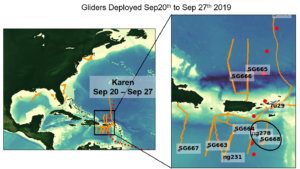
There is a good agreement in the vertical structure of temperature between GOFS 3.1 and the glider temperature (below).
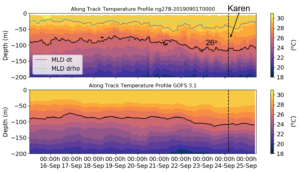
The GOFS 3.1 model, however, has a surface fresh layer (barrier layer) that is not as sharp as the observations show. This barrier layer gets even fresher and shallower during Karen (below). At the moment we are investigating if this freshening can be attributed to increased precipitation during the storm. If this is the case, this can be a mechanism that reinforces stratification during a storm and inhibits vertical mixing. We would like to investigate how important this possible mechanism is in controlling the storm intensity.
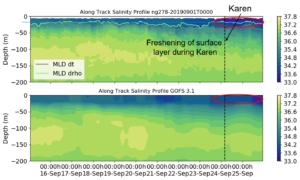
The freshening that happened during Karen (Sep 23 – Sep 24) is not initially captured by any of the models (below).
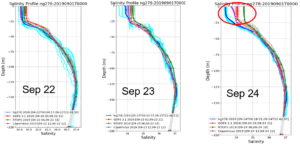
By Sep 26, the surface salinity in GOFS and Copernicus were much closer to the observations (both models assimilate data) but RTOFS still lags behind (below).

Images of these daily comparisons, since the inception of the 2019 hurricane season, are available here.
-
There are a lot of gliders out there!
Posted on October 1st, 2019 No commentsThe 2019 hurricane season is in full swing in the Atlantic Ocean. Since the inception of the hurricane season on June 1, 42 ocean gliders have been deployed in the western Atlantic ocean by numerous academic, corporate and government partners. These gliders have acquired over 68,000 profiles of temperature and salinity to date. Some gliders also record data on water optics, oxygen, current speeds, pH, and wave heights. A distribution of the groups funding the deployments is shown below as well as a map of their locations.
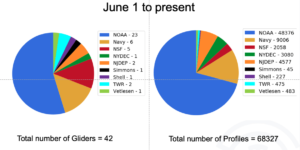
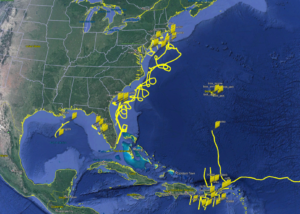
-
Salinity Adjustment Ahead of Hurricane Dorian
Posted on September 27th, 2019 No commentsAccurate ocean initial conditions in numerical models are necessary to improve hurricane intensity forecasts (see article). One way to improve the initial conditions in operational ocean models is to use data assimilation, a technique that allows a numerical model to ingest observational data to nudge the model predictions closer to reality. The goal of the comparisons is to evaluate how data assimilation is impacting the model performance and ultimately how ocean processes affect storm intensity. Images of these daily comparisons, since the inception of the 2019 hurricane season, are available here.
For the daily comparisons we use three operational ocean models: Global Ocean Forecasting System (GOFS 3.1, Navy), Real Time Ocean Forecasting System (RTOFS, NOAA) and the operational Mercator global ocean analysis and forecast system (Copernicus).
During Hurricane Dorian there were a total of seven gliders deployed in the Caribbean reporting to the IOOS glider data assembly center (IOOS Glider DAC). Once the gliders start reporting data to the IOOS glider DAC, the data is sent to the Global Telecommunication System (GTS) where it can be assimilated by ocean models.
On August 29, Tropical Storm Dorian passed over three gliders: SG665, SG666 and SG668 (Figure 1).
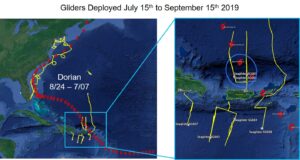
Figures 2a-2d below highlight the comparisons of the models to glider SG665. In general, the operational ocean models capture the temperature structure in the Caribbean (Fig. 2a and 2b), however, in this example, the models tend to underestimate salinity at the surface and subsurface salinity maximum around 200 meters in this area. The assimilation of glider data into operational ocean models plays a very important role in correcting the subsurface and surface salinity structure. An example of this correction is highlighted in figures c and d. GOFS 3.1 (red line) is shown in figure c on the first full day of the glider deployment. Figure d shows a shift of 0.4 psu after a week of assimilation, pushing GOFS 3.1 much closer to the reality of the salinity structure.
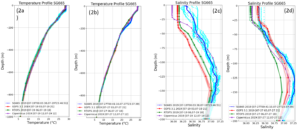
-
International Challenger RU29 Mission Update
Posted on September 12th, 2019 No commentsRU29 is tuning up to measure currents: RU29 spent the day profiling in about 1000 m depths off Virgin Gorda, with operators tweaking settings on the onboard Doppler current velocity profiler to optimize its ability to measure ocean currents. An important aspect of the mission will be measuring speed and direction of currents below the surface to determine the movement of the water masses distinguished by their temperature and salinity characteristics.
Currents in the region can be strong and have complex patterns. The figure below shows the modeled (US Navy AMSEAS model) currents in the region for 11 September, 2019. RU29 is in an area of northward surface currents greater than 1 knot. Ocean gliders themselves are only capable of forward speeds of around 0.5 knots, and only when they are ascending or descending. In order to make headway, they depend on spending most of their time well below the surface, where the currents are generally slower. If necessary, the glider does have a small electric motor and propeller which it can use, but at the cost of tapping into its limited battery reserves.
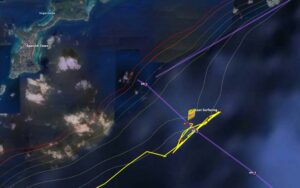
RU29 recent trackline and position on 11 September 2019. The glider should begin its trip across the Anegada Passage station line on 12 September.
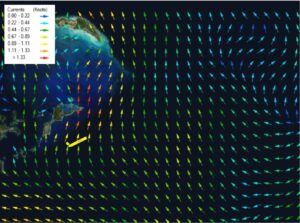
Modeled surface current vectors from the US Navy AMSEAS model from 2100 UTC, 11 September, 2019. From OCEANSMAP Caribbean.
To see all of the current reports, you can view them here: http://ocovi.azurewebsites.net/resource/Ru29
The International Challenger RU29 Mission is a collaboration among Rutgers University (New Brunswick, NJ) Center for Ocean Observing Leadership, Ocean and Coastal Observing – Virgin Islands (OCOVI, an affiliate of the US Integrated Ocean Observing System (IOOS) Caribbean Coastal and Ocean Observing System (CARICOOS)), and the University of the Virgin Islands. This mission will collect upper ocean data to improve hurricane forecasting models; study conditions in the Anegada Passage, an important region for NE Caribbean climate change; and build international cooperation for ocean observing and glider activities. The mission will work in the waters of the US Virgin Islands, British Virgin Islands, and Anguilla, under international Marine Science Research permit . Funding for the project comes from the U.S. National Oceanic and Atmosheric Adminstration through the IOOS, Rutgers University, and the G. Unger Vetlesen Foundation.
-
RUCOOL Updates June-July 2019
Posted on August 18th, 2019 No commentsField Campaign & Science Updates
State
- RUCOOL hosted a workshop sponsored by NJBPU and MARACOOS that focused on the environmental impacts of offshore wind. Based on feedback from stakeholders, we focused our workshop theme on the Cold Pool, an important oceanographic feature unique to the waters off the New Jersey coast. The workshop had representatives from federal and state government, wind developers, commercial and recreation fishers, and academic experts across the region. Together the participants shared the latest science and identified specific research needs for the community as wind farms development moves forward throughout the Mid-Atlantic Bight.
- RUCOOL faculty continue to interact with the state on the ongoing effort to stand up a Wind Institute. Josh Kohut drafted a proposed plan for the formation of a Wind Institute that was co-authored by partners at Monmouth University and Stockton University, which was shared with Governor Murphy’s office.
- RUCOOL deployed glider RU28 in July for NJDEP coastal water quality research. The glider team also deployed the world’s first pH glider (RU30) in July for NSF. RUCOOL assisted with deploying and piloting StonyBrook1, the first Stony Brook University Glider. We expect to use the RV Rutgers to recover both RU30 and SB1 in mid-August.
- The RV Rutgers was deployed on 11 cruises for 6 different PIs during June and July.
- Seven DMCS students attended a new Integrated Ocean Observing software course. This course provides the data literacy foundation for the new Masters in Integrated Ocean Observing program beginning this fall.
National
- DMCS welcomed 13 undergraduate students from across the country to participate in our NSF funded REU program, RIOS. These students worked with mentors over a 10 week program that supported their research and provided weekly workshops that developed their career and research aptitude. The program was coordinated by Josh Kohut, and additionally 3 other RUCOOL scientists directly mentored students, and two RUCOOL scientists supported the RIOS career workshop. The summer program concluded with a science symposium in which the students shared their work and celebrated their research success.
- RUCOOL hosted our second OOI Ocean Data Lab Professional Development Workshopin June at Rutgers, and our third in July at Asilomar Conference Grounds in Pacific Grove, CA. Twenty-one faculty from community colleges, primarily undergraduate institutions, and universities from Hawaii to Rhode Island and all points in between joined us at these two workshops. Teachers learned how to use and develop their own educational resources from real-time an archived OOI data that they can take back to their classrooms reaching students who may not otherwise have any experience in ocean science. Workshop information is at the Data Labs Workshops
- RUCOOL hosted our firstOOI Data Mini-Workshop at the July Earth Educators’ Rendezvous in Nashville, TN, where over 30 faculty learned about the OOI, data literacy, the learning cycle, and the collection of interactive data widgets being developed by our community members.
- NOAA EMC Meeting DC July 19 – RUCOOL attended a hurricane intensity forecast meetings with OAR, NOS and NWS, building the connection between Rutgers and GFDL in Princeton for development of the MOM6 model. This is the future ocean model for NOAA. NOAA has requested RUCOOL assistance with model data comparisons and assimilation.
- Oscar Schofield co-Chaired the external review of the Naval Research Laboratories Battlespace Environmental Program at Stennis Center.
International
- Korea: Scott Glenn of RUCOOL, and Alan Leonardi, head of Ocean Exploration at NOAA, were invited to Korea to lead the conference on the “US Experts Invitational Seminar on Underwater Gliders and Deep Sea Explorations”. KIOST, the Korean Ministry of Oceans and Fisheries, and NOAA sponsored this meeting.
- Japan: Oscar Schofield attended and presented at the Global Ocean Observing System General Regional Associations in Tokyo (July 5th-July 8th 2019). He was representing the growing Southern Ocean Observing System.
Student Awards
- Sarah Murphy and Julia Engdahl, RUCOOL graduate students, were both awarded MTS tuition scholarships.
Papers Published: (**Current or Former Graduate Student or Postdoctoral Researchers)
- Slesinger, E., Andres, A., Young, R., Seibel, B., Saba, V., Phelan, B., Rosendale, J., Wieczorek, D., Saba, G. 2019. The effect of ocean warming on black sea bass (Centropristis striata) aerobic scope and hypoxia tolerance. PLoS ONE 14 (6): e0218390. https://doi.org/10.1371/journal.pone.0218390.
- Brown, M. S., Munro, D. R., Feehan, C. J., Sweeney, C., Ducklow, H. W., Schofield, O. 2019. Enhanced oceanic CO2 uptake along the rapidly changing West Antarctic Peninsula. Nature Climate Change. DOI:10.1038/s41558-019-0552-3.
- Louise Newman, Petra Heil , Rowan Trebilco, Katsuro Katsumata, Andrew Constable , Esmee van Wijk , Karen Assmann , Oscar Schofield, Elisabeth Sikes and 31 others. 2019. Delivering Sustained, Coordinated, and Integrated Observations of the Southern Ocean for Global Impact, Frontiers in Marine Science. doi: 10.3389/fmars.2019.00433.
- Ricardo Domingues , Akira Kuwano-Yoshida , Patricia Chardon-Maldonado , Robert E. Todd , George Halliwell, Hyun-Sook Kim, I.-I. Lin, Travis Miles, Scott Glenn and 20 others. Ocean Observations in Support of Studies and Forecasts of Tropical and Extratropical Cyclones, Frontiers in Marine Science. doi: 10.3389/fmars.2019.00446.
- Pierre Testor , Brad DeYoung , Daniel L. Rudnick , Scott Glenn, Nicholas Beaird , Travis Miles, Grace Saba, Josh Kohut and 81 additional authors. OceanGliders: a component of the integrated GOOS. 2019. Frontiers in Marine Science. doi: 10.3389/fmars.2019.00422.
- Jessica N. Cross , Jessie A. Turner , Sarah R. Cooley , Jan A. Newton , Kumiko Azetsu-Scott , R. Christopher Chambers, Grace Saba and 16 others. 2019. Building the Knowledge-to-Action Pipeline in North America: Connecting Ocean Acidification Research and Actionable Decision Support. Frontiers in Marine Science. doi: 10.3389/fmars.2019.00356.
- Hugh Roarty , Thomas Cook , Lisa Hazard, Doug George, Jack Harlan, Simone Cosoli , Lucy Wyatt, Enrique Alvarez Fanjul , Eric Terrill, Mark Otero, John Largier, Scott Glenn, and 21 other authors. 2019. The Global High Frequency Radar Network. Frontiers in Marine Science. doi: 10.3389/fmars.2019.00164.
RUCOOL Meetings & Conferences
RIOS at JCNEER, Tuckerton, NJ; Cold Pool Workshop, Tuckerton, NJ; RUCOOL Glider Camp, New Brunswick, NJ; 2nd OOI Ocean Data Lab Professional Development Workshop, New Brunswick, NJ; 3rd OOI Ocean Data Lab Professional Development Workshop, Pacific Grove, CA; OOI Data Mini-Workshop, Nashville, TN; NOAA EMC Meetings, Washington, DC; US Experts Invitational Seminar on Underwater Gliders and Deep Sea Explorations, Seoul, Korea; Wind Turbine Radar Interference Mitigation Strategy Meeting, Travis AFB, CA; SWARM Glider Calibration Meeting, San Diego, CA; 4DVAR ROMS Assimilation Workshop, College Park, MD; NRL External Review, Stennis, MS.
RUCOOL Visitors
- Total number of visitors to RU COOL: 242
-
RUCOOL Updates April-May 2019
Posted on June 15th, 2019 No commentsRUCOOL Updates: April – May 2019
Field Campaign & Science Updates
State
- RUCOOL hosted a visit from the Fisheries Liaison with offshore wind developer Equinor to discuss our technical capabilities and possible future collaborations.
- Several members of the RUCOOL team attended the Fourteenth Annual REI Energy Symposium on May 8. Scott Glenn gave a plenary presentation while several members of the team ran afternoon breakout sessions focused on real-time ocean data delivery through RUCOOL and MARACOOS.
- RUCOOL attended the NJAES Board of Managers meeting and presented Rutgers activities in offshore wind. Our next step is to identify links between agriculture and marine capacities in NJAES.
- With Executive SEBS leadership, RUCOOL met with the Wentworth family to develop a contaminant observing system spanning the Raritan to the deep sea. The Wentworths are supportive of helping fund this vision.
- RUCOOL attended the American Wind Energy Association Meeting to present an overview of RUCOOL offshore wind projects.
National
- RUCOOL chaired and presented in a session on research partnerships, and as part of a briefing on NJ’s offshore wind strategic plan, at the Offshore Wind International Partnering Forum in NYC, April 8-10.
- RUCOOL briefed NOAA leadership Craig McLean, the Assistant Administrator of OAR, and Nicole LeBoeuf, Acting Assistant Administrator of NOS, on hurricane research and the need for a dedicated hurricane glider fleet (April 22nd). Scott glenn and Gustavo Goni (NOAA/AOML) were tasked with designing the US hurricane glider fleet.
- RUCOOL organized and chaired the Mid-Atlantic Coastal Acidification Network (MACAN) Workshop in Baltimore, May 13. RUCOOL has assumed the leadership role on ocean acidification research and planning in the region.
- Several members of RUCOOL attended, presented and led panels on hurricane research and wind energy development at the MARACOOS annual meeting in Baltimore, May 13-14.
- Scott April 30 Craig McLean, Acting Chief Scientist at NOAA, visited RUCOOL to discuss the future planning of the hurricane glider fleet and speak at the undergraduate Ocean Observing class.
- RUCOOL briefed the Joint Typhoon Warning Center in Pearl Harbor, HI on the impact of ocean glider observations on hurricane intensity forecast improvement April 10-11.
- Oscar Schofield met with the Deputy Director of Polar Programs at NSF to discuss future of the Antarctic Ship fleet and need to automate sampling.
International
- RUCOOL hosted the first ever EGO/UG2 International Glider Meeting May 20-24. Over 130 researchers and glider operators from 17 countries attended the meeting. The presentations will soon be available through gliders.ioos.us.
- Oscar Schofield attended the LTER Principal Investigator Annual Meeting in Puerto Rico, with a focus on developing an international time series network.
- Scott Glenn and Craig McLean co-hosted the US Committee meeting for the Intergovernmental Oceanographic Commission to prepare the US delegation for the July General Assembly meeting at UNESCO in Paris.
- Travis Miles was appointed as chair of the Marine Technology Society (MTS) Meteorology and Physical Oceanography Committee.
- Scott Glenn’s presentation at IOCARIBE launched a follow on meeting scheduled for November in Mexico City to design the climate monitoring network for the Caribbean through-flow portion of the global conveyor belt.
Papers Published: (**Current or Former Graduate Student or Postdoctoral Researchers)
- Archer, C.L., Brodie, J.F., and Rauscher, S.A. 2019. Global warming will aggravate ozone pollution in the U.S. Mid-Atlantic. Journal of Applied Meteorology and Climatology. https://doi.org/10.1175/JAMC-D-18-0263.1.
- Goldsmith, K.A., Lau, S., Poach, M.E., Sakowicz, G.P., Trice, T.M., Ono, R.C., Nye, J., Shadwick, E.H., St.Laurent, K.A., Saba, G.K. Scientific Considerations for Acidification Monitoring in the U.S. Mid-Atlantic Region. Estuarine, Coastal and Shelf Science. https://doi.org/10.1016/j.ecss.2019.04.023.
- Saba, G.K., Goldsmith, K.A., Cooley, S.R., Grosse, D., Meseck, S.L., Miller, W., Phelan, B., Poach, M., Rheault, R., St. Laurent, K., Testa, J., Weis, J.S., Zimmerman, R. 2019. Recommended Priorities for Research on Ecological Impacts of Coastal and Ocean Acidification in the U.S. Mid-Atlantic. Estuarine, Coastal and Shelf Science. https://doi.org/10.1016/j.ecss.2019.04.022.
- Roarty, H., T. Cook, L. Hazard, D. George, J. Harlan, S. Cosoli, L. Wyatt, E. Alvarez Fanjul, E. Terrill, M. Otero, J. Largier, S. Glenn, N. Ebuchi, B. Whitehouse, K. Bartlett, J. Mader, A. Rubio, L. Corgnati, C. Mantovani, A. Griffa, E. Reyes, P. Lorente, X. Flores-Vidal, K. J. Saavedra-Matta, P. Rogowski, S. Prukpitikul, S.-H. Lee, J.-W. Lai, C.-A. Guerin, J. Sanchez, B. Hansen and S. Grilli (2019). “The Global High Frequency Radar Network.” Frontiers in Marine Science 6(164).
RUCOOL Meetings & Conferences
Gulf of Mexico Coastal Ocean Observing System Annual Meeting: New Orleans. JTWC Tropical Cyclone Conference: Honolulu. Scott Glenn and Oscar Schofield attended meeting NOAA leadership in Washington DC on the need for a national hurricane glider network April 22. IOOS DMAC Annual meeting: Washington D.C. April 29-May 2. Intergovernmental Oceanographic Commission Meeting: Washington D.C. May 1. National Ocean Partnership Program Meeting in Washington DC April 21-22. Mid-Atlantic Coastal Acidification Network (MACAN) Workshop: Baltimore May 13. MARACOOS Board Meeting: Baltimore May 13. MARACOOS Annual Meeting Baltimore May 13-14. LTER Principal Investigator meeting May 14-16, NOAA Environmental Monitoring Center (NCEP), April 2. EGO/UG2 International Glider Meeting: hosted at Rutgers May 20-24. CARICOOS Annual Meeting, May 24.
RUCOOL Visitors
- Total number of visitors to RU COOL: 127
- Selected VIP Visitors:
Peter Seligman – Chairman Conservation International, Craig McLean – Acting Chief Scientist at NOAA, Douglas Webb – founder of Teledyne Webb Research (Slocum Glider), Benjamin LaCour – NOAA IOOS, Mark Bushnell – NOAA IOOS, Nick Rome – IOOC Program Manager Consortium for Ocean Leadership, Gustavo Goni – Division Director NOAA/AOML, Barbara Kirkpatrick – Executive Director GCOOS, Steven DiMarco – Texas A&M University, Victor Turpin – JCOMMOPS, Emma Heslop – IOC/UNESCO, Steve Drew – Equinor Fisheries Liaison, Pierre Testor – French National Center for Scientific Research.
-
RUCOOL Updates for February-March 2019
Posted on April 11th, 2019 No commentsRUCOOL Updates: February – March 2019
Field Campaign & Science Updates
State
- RUCOOL hosted two meetings held by NJBPU for NJ’s Offshore Wind Strategic Plan. These meetings were stakeholder roundtable discussions with environmental & fisheries stakeholders held at IFNH, and included RUCOOL tours.
- RUCOOL was one of two representatives of RU at a WIND Institute planning meeting hosted by NJEDA and the Office of Secretary of Higher Education.
- RUCOOL hosted a meeting with regional commercial fishers, RUCOOL faculty and staff, and other RU faculty to discuss research needs given the planned offshore wind development in our region.
- Mid-Atlantic Ocean Forum, Monmouth University: RUCOOL networked with several people regarding ongoing offshore wind and fisheries interests, and Grace led a breakout session focused on ocean acidification.
- RU30 pH glider with oxygen (pHoxy Lady) was deployed for one month of pH, oxygen, temperature and salinity measurements across the NJ shelf. This is the start of several pH glider deployments for 2019 to observe seasonal carbonate chemistry dynamics.
- Hugh Roarty Testifies that COOL HF-Radar data proves “Sarah Stern’s body was swept out to sea before anyone could find it.”
National
- RUCOOL hosted a visit by the MTS leadership that immersed their administrative staff into hands on oceanographic research and enabled our undergraduate students to meet and discuss their research with MTS leadership. MTS awarded RUCOOL 15 free memberships for Rutgers undergraduate students.
- RUCOOL initiated discussions at NOAA EMC, the Naval Research Laboratory, and the Naval Oceanographic Office on the use of gliders in hurricane intensity forecasting. This included presentations on glider data impact studies from the 2018 hurricane season and planning sessions for the 2019 Hurricane glider deployments.
- RUCOOL was a technical lead and presented at the IEEE Current Measurement, Turbulence and Applications meeting in San Diego, CA.
- RUCOOL attended an invite-only US DOE Workshop on Research Needs for Offshore Wind Resource Characterization in Washington, DC, March 5-6.
- RUCOOL was featured on the Bigten LiveBIG YouTube Channel Video.
International
- RUCOOL completed an 8-week ecosystem survey along the West Antarctic Peninsula.
- RUCOOL continues to prepare for the EGO/UG2 International Glider Meeting in May. Members of COL and IOOS visited RUCOOL March 14th for a strategic planning session.
- Working with Texas AM to raise funds from a donor for support of building CUBA ocean observing. The Chancellor of Texas AM committed dollar for dollar match for the first 300K of the donor contribution to purchase CODARS for CUBA.
- Erick Fredj from the Jerusalem College of Technology completed his two month sabbatical hosted at RUCOOL. Erick worked on several collaborative projects including sea breeze, Antarctic ecosystem and HF radar research.
Papers Published: (**Current or Former Graduate Student or Postdoctoral Researchers)
- Cristina L Archer, Sicheng Wu, Ahmad Vasel-Be-Hagh, Joseph F Brodie, Ruben Delgado, Alexandra St. Pé, Steven Oncley, Steven Semmer. The VERTEX field campaign: observations of near-ground effects of wind turbine wakes, Journal of Turbulence, https://doi.org/10.1080/14685248.2019.1572161.
- Mattias R. Cape, Fiammetta Straneo, Nicholas Beaird, Randelle M. Bundy and Matthew A. Charette. Nutrient release to oceans from buoyancy-driven upwelling at Greenland tidewater glaciers. Nature Geoscience:
A Nature Research Journal. https://doi.org/10.1038/s41561-018-0268-4. - Evan B. Clark, Andrew Branch, Steve Chien, Faiz Mirza, John D. Farrara, Yi Chao, David Fratantoni, David Aragon, Oscar Schofield, Mar M. Flexas, and Andrew Thompson. Station-Keeping Underwater Gliders Using a Predictive Ocean Circulation Model and Applications to SWOT Calibration and Validation. IEEE Journal of Oceanic Engineering. 1109/JOE.2018.2886092.
- Colette J. Feehan, William C. Sharp, Travis N. Miles, Michael S. Brown**, Diane K. Adams. Larval influx of Diadema antillarum to the Florida Keys linked to passage of a Tortugas Eddy. Coral Reefspp 1–7. DOI: 1007/s00338-019-01786-9.
- Sian F. Henley, Oscar M. Schofield, Katharine R. Hendry, Irene R. Schloss, Deborah K. Steinberg, Carlos Moffat, Lloyd S. Peck, Daniel P. Costa, Dorothee C.E. Bakker, Claire Hughes, Patrick D. Rozema, Hugh W. Ducklow, Doris Abele, Jacqueline Stefels, Maria A. Van Leeuwe, Corina P.D. Brussaard, Anita G.J. Buma, Josh Kohut, Ricardo Sahade, Ari S. Friedlaender, Sharon E. Stammerjohn, Hugh J. Venables, Michael P. Meredith. Variability and change in the west Antarctic Peninsula marine system: Research priorities and opportunities, Progress in Oceanography Vol.173. https://doi.org/10.1016/j.pocean.2019.03.003.
- **McKee, D., Martinson, D. G., Schofield, O. 2019. Origin and attenuation of mesoscale structure in circumpolar deep water intrusions to an Antarctic shelf. Journal of Physical Oceanography. doi:10.1175/JPO-D-18-0133.1.
- Oliver, M., Kohut, J., Bernard, K., Fraser, W., Winsor, P., Statscewich, H., Fredj, E., Cimino, M., Patterson-Fraser, D., Carvalho, F. 2019. Central place foragers select ocean surface convergent features despite differing foraging strategies. Scientific Reports, 9, 157. 9:157 DOI:10.1038/s41598-018-35901-7.
- **Yajuan Lin, Scott Gifford, Hugh Ducklow, Oscar Schofield, Nicolas Cassar. Towards Quantitative Microbiome Community Profiling Using Internal Standards, American Society for Microbiology | Applied and Environmental Microbiology. DOI: 10.1128/AEM.02634-18.
RUCOOL Meetings & Conferences
Oceanology International San Diego, RUCOOL hosted BPU Feb 21, RUCOOL represented Rutgers at the NJ Wind Institute Meeting in Trenton on March 22nd, RUCOOL supported the February 27-28th OOI Review with the Consortium for Ocean Leadership at the CORE building on Busch Campus, Tropical Cyclone Operations and Research Forum, Miami, FL, IOOS Annual Executive Directors Meeting, Washington, D.C, OOI 1.0 Closing meeting February 28 at CORE Building, Technical Chair and Student Contact for the 12t IEEE Currents, Waves and Turbulence Measurement Workshop http://cwtm2019.org, Hugh Roarty is serving a four year term as Chair of the IEEE Currents, Waves, Turbulence Measurement and Applications Technology Committee
RUCOOL Visitors
- Total number of visitors to RU COOL: 120
- Some VIP Visitors:
Rick Spinrad, President, Marine Technology Society, Zdenka Willis, President-elect, Marine Technology Society, Donna Kocak, Immediate Past President, Marine Technology Society, Liesl Hotaling, Vice President of Education, Marine Technology Society, Ruth Perry, Marine Scientist and Regulatory Policy, Shell Exploration and Production Americas team, Doug Copeland, Regional Development Manager at EDF Renewables, Krisa Arzayus, Deputy Director, US IOOS, Brick Wenzel, Ocean County Farm Bureau , Jeremy Grunin, Grunin Foundation, Peter Seligmann, Chair of Conservation International, Hurricane meetings at National Research Lab, Invited seminar at University of Maine, Invited Public Talk as part of the Ambassador John Price & Marcia Price World Affairs Lecture Utah, American Society of Limnology and Oceanography, Puerto Rico.
-
RUCOOL Updates for December 2018 – January 2019
Posted on February 5th, 2019 No commentsRUCOOL Updates: December 2018 – January 2019
Field Campaign & Science Updates
State
- RUCOOL is coordinating the Rutgers interaction with various state agencies as they develop the framework for a WIND Institute focused on research and workforce development in the emerging offshore wind sector.
- RUCOOL attended an RU Meet and Greet with state officials framing the WIND institute.
- RUCOOL (met with local NJ Farm Bureau (Brick Wenzel) to discuss research needs that explore links between offshore met-ocean conditions and coastal farms and the potential impacts of offshore wind farms.
- RUCOOL met with the Responsible Ocean Development Alliance (RODA) and fishing industry partners in Cape May, Kohut, Miles, Munroe, Zimeckis and Brodie
- RUCOOL served as expert panelists for NJ BPU Public Stakeholder Meetings for the NJ Offshore Wind Strategic Plan in early December
- RUCOOL Article: A New Way to Predict Sea Breezes May Benefit Offshore Wind Farms. Carried by numerous outlets including but not limited to: futurity.org, newswise.com, reddit.com, offshorewind.biz, Enginnering360, and NJ 101.5 interview (Joe Cutter).
National
- A point paper on glider data assimilation in Navy and NOAA ocean models requested by Admiral Okon’s Technical Director, Bill Burnett, after the November NOAA/Navy leadership brief was submitted to Navy and NOAA, forming the basis for visits to CNMOC and NRL in February.
- Began work with IOOS leadership to establish a sustained funding process for the Hurricane Sentinel Glider Picket Lines successfully demonstrated during the 2018 Hurricane Season.
- RUCOOL co-hosted the polar-izing your science NSF workshop with University of Delaware. The workshop introduced polar scientists from around the world to several science communication tools to broaden the impact of their research.
- Miles et al., Initial impacts of the Hurricane Sentinel glider fleet deployed during the 2018 hurricane season, AGU Fall Meeting special session on the 2018 Hurricane Season
- Brodie et al., Utilizing Climatological Analysis to Improve Forecasting of Offshore Wind Ramps, AMS Annual Meeting, 10th Conference on Weather, Climate, and the New Energy Economy.
International
- RUCOOL at Palmer Station Antarctica deploys glider outfitted with multi-frequency acoustic system to measure krill abundance.
- RUCOOL begins 8-week ecosystem survey along the West Antarctic Peninsula
- New collaboration with the University of Perpignan, France, to deploy gliders in the Gulf of Lyons
- RUCOOL hosts the Marine Technology Society (MTS) Unmanned Untethered Vehicle (UUV) Committee town hall at AGU in Washington, DC
- RUCOOL official government issued diplomat visas issued by Cuba for the January visit to INSMET, enabling RUCOOL personnel to visit Cuban government weather radar sites to plan for future HF radar installations
- RUCOOL visited Texas A&M University to begin planning the tri-national glider effort to observe the Loop Current for the National Academy of Sciences decadal Loop Current program.
- RUCOOL attended the National Academies of Science Loop Current kick off meeting and presented a unified approach to HF Radar data quality and management, now considered to be the National Gold Standard for HF Radar.
- RUCOOL traveled to Ensenada, Mexico for the second tri-national planning meeting for the Loop Current glider observation program.
- RUCOOL delivered a short course on underwater glider technology to Chilean students at the University of Valparaiso.
- Erick Fredj from the Jerusalem College of Technology began his two month sabbatical hosted at RUCOOL. Erick will work on several collaborative projects including sea breeze, Antarctic ecosystem and HF radar research.
Papers: (**Current or Former Graduate Student or Postdoctoral Researchers)
Published:
- Cross, J.N., Turner, J., Cooley, S.R., Newton, J., Azetsu-Scott, K., Braby, C.E., Canesi, K., Chambers, C., Dugan, D., Goldsmith, K., Gurney-Smith, H., Harper, A., Jewett, L., Joy, D., King, T., Kurz, M., Morrison, R., Motyka, J., Ombres, E., Paguirigan, M., Regula-Whitefield, C.M., Saba, G.K., Silva, E., Smits, E., Vreeland-Dawson, J., Wickes, L. Submitted to Frontiers in Marine Science. The Knowledge-to-Action Pipeline: Connecting Ocean Acidification Research and Actionable Decision Support. Community white paper for OceanObs’19, September 2019, Honolulu, HI.
- **Oliver, M., Kohut, J., Bernard, K., Fraser, W., Winsor, P., **Statscewich, H., Fredj, E., Cimino, M., Patterson-Fraser, D., **Carvalho, F. 2019. Central place foragers select ocean surface convergent features despite differing foraging strategies. Scientific Reports. Vol 9, Article #157.
- Testor, P., DeYoung, B., Rudnick, D., Glenn, S., Hayes, D., Lee, C., Pattiaratchi, C., Turpin, V., Heslop, E., Saba, G., Kohut, J., Schofield, O., Miles, T., and 88 others. Submitted to Frontiers in Marine Science. Ocean gliders: A component of the integrated Global Ocean Observing System (GOOS). Community white paper for OceanObs’19, September 2019, Honolulu, HI.
In Press:
- Clark, E., Chien, S., Farrara, J. Fratantoni, D., Schofield, O., Thompson A., Branch, A., Mirza, F., Chao, Y., Aragon, D., Flexas, M. Precise station keeping for underwater gliders using a predictive ocean current model. Journal of Ocean Engineering. In press.
- Lin, Y., Gifford, S. Ducklow, H., Schofield, O., Cassar, N. Towards quantitative marine microbiome community profiling using internal standards ISME. In press.
- McKee, D., Martinson, D. G., Schofield, O. Origin and attenuation of mesoscale structure in circumpolar deep water intrusions to an Antarctic shelf. Journal of Physical Oceanography. In press.
- Miles, T., Slade, W., **Gong, D., and Kohut, J. Suspended particle characteristics from a Glider integrated LISST sensor. MTS/IEEE Oceans. Charleston, SC. In Press.
- Prakash, Dicopoulos, Roarty, Morel, Canals, **Evans (2018) “Development of Sargassum Seaweed Tracking Tools” MTS Oceans. In press.
Submitted:
- Archer, C.L., Brodie, J.F., Rauscher, S.A. Global warming will aggravate ozone pollution in the U.S. Mid-Atlantic, Journal of Applied Meteorology and Climatology.
- Friedland, K. D., Morse, R. E., Manning, J.P., Melrose, C.D., Miles, T.N., Goode, A., Brady, D. C., Kohut, J., Thomas, A.C., Powell, E.N. Disjunctive Regime Shifts in Surface and Bottom Thermal Environments of a Continental Shelf Ecosystem, J. Geophys. Res. Oceans.
- Goldsmith, K.A., Lau, S., Poach, M.E., Sakowicz, G.P., Trice, T.M., Ono, R.C., Nye, J., Shadwick, E.H., Saba, G.K. In review. Scientific Considerations for Acidification Monitoring in the U.S. Mid-Atlantic Region. Estuarine, Coastal and Shelf Science.
- Kobelt, J., Sharp, W., Miles, T., Feehan, C., Localized impacts of Hurricane Irma on Diadema antillarum and coral reef community structure, Estuaries and Coasts.
- Parra, S., Greer, A., Book, J., Deary, A., Soto, I., Culpepper, C., Hernandez, F., Miles, T., Acoustic detection of zooplankton diel vertical migration behaviors on the northern Gulf of Mexico shelf, Limnology and Oceanography.
- Saba, G.K., Goldsmith, K.A., Cooley, S.R., Grosse, D., Meseck, S.L., Miller, W., Phelan, B., Poach, M., Rheault, R., St. Laurent, K., Testa, J., Weis, J.S., Zimmerman, R. Recommended Priorities for Research on Ecological Impacts of Coastal and Ocean Acidification in the U.S. Mid-Atlantic. Estuarine, Coastal and Shelf Science.
- Saba, G.K., **’Wright-Fairbanks, E., Chen, B., Cai, W.-J., Barnard, A.H., Jones, C.P., Branham, C.W., Wang, K., Miles, T. The development and validation of a profiling glider Deep ISFET pH sensor for high resolution coastal ocean acidification monitoring. Frontiers in Marine Science.
- **Slesinger, E., Andres, A., Young, R., Seibel, B., Saba, V., Phelan, B., Rosendale, J., Wieczorek, D., Saba, G The effect of ocean warming on black sea bass (Centropristis striata) aerobic scope and hypoxia tolerance. PLoS ONE. Submitted.
RUCOOL Significant Meetings & Conferences
- Dalio Foundation, NJ Agency of Development (Wind Institute formation), Rutgers Library Deans (Giddings Collection), International POGO meeting (Cape Verde), RUMFS Tuckerton Science Retreat
RUCOOL Visitors
- Total number of visitors to RU COOL: 13 (Dec/Jan are typically the lowest visitor traffic months of the year)
- Visitors: Equinor, SMART Congressional Initiative
-
Early Season at Palmer
Posted on January 7th, 2019 No comments2018 Spring Phytoplankton Bloom!
After 30 hours of travel from the US to Punta Arenas, Chile, and then a four-day transit on R/V Laurence M. Gould across the Drake Passage, Marie Zahn and Anna Bashkirova representing the Schofield team arrived on October 6th, 2018 to Palmer Station.
Typically foul weather conditions inhibit early season sampling, but this year’s open water and manageable winds allowed us to completely capture the first spring phytoplankton bloom, peaking around November 19th.
Wind speed decreased after the first week of November and sea ice retreated, allowing sufficient sunlight and water column stratification for a bloom. Stratification was especially pronounced November 15-19 and best observable in salinity and density values from CTD profiles collected at two locations: Stations B (nearshore) and E (offshore). This was accompanied by a steady rise in fluorescence, primary production, and chlorophyll concentrations, all three reaching a peak on November 19th. Strong winds beginning November 18th soon mixed the water column, quenching the bloom.
Our measurements of primary production (mg C/m2/day) and chlorophyll concentrations (mg/m2) dropped down after the spring bloom and have remained steady since. Fluorescence profiles also reflect the spring bloom (reaching nearly 10 mg/m3 at the chlorophyll maximum) and subsequent leveling-off to ~3 mg/m3 for both Stations B and E.
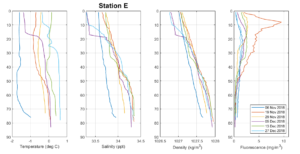
Temperature (˚C), salinity (ppt), density (kg m-3), and fluorescence (mg m-3) profiles against depth in meters (L-R) for six November and December 2018 sampling events at Station B (top row) and Station E (bottom row).
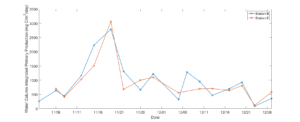
Depth-integrated primary production (mg C/m2/day) values from Station B (blue) and Station E (orange) for November and December 2018.



